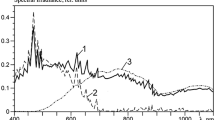Abstract
To overcome the limitations of conventional solar simulators, which suffer from inadequate irradiance adjustment range, poor adjustment accuracy, serious arc displacement of the xenon lamp at the low power supply, and insufficient consideration of irradiance uniformity, we have designed an electrically controlled irradiance continuous adjustment device. Our approach involves a theoretical analysis of the radiation distribution on the attenuation diaphragm using the annular aperture method of a condenser, enabling modulation of the radiation distribution of the converging light path using a sector-shaped mesh structure with carefully calculated and simulated structural parameters.We then determined the structural scheme of the electrically controlled irradiance continuous adjustment device, which incorporates an attenuation diaphragm, a dimming dial, rolling balls, a cage, pinions, a motor fixation plate, a triangular bracket, and an electric control system. Key components were designed and optimized using finite element analysis, and the control system was also studied.In the final step, we tested the performance of the electrically controlled irradiance continuous adjustment device. Experimental results demonstrated that the irradiance of the solar simulator can be adjusted within the range of 23.7–1315.5 W/m2, with a maximum relative error of the attenuation ratio within ± 0.2% and irradiance non-uniformity within ± 3%. Our device has achieved electrically controlled irradiance continuous adjustment, thereby expanding the application range of the solar simulator and improving its overall performance.















Similar content being viewed by others
Availability of data and materials
Not applicable.
Code availability
Not applicable.
References
Abuseada, M., Ophoff, C., Ozalp, N.: Characterization of a new 10 kwe high flux solar simulator via indirect radiation mapping technique. J. Solar Energy Eng. 141(2), 021005–021019 (2019). https://doi.org/10.1115/1.4042246
Alxneit, I.: Measuring temperatures in a high concentration solar simulator—demonstration of the principle. Sol. Energy 85(3), 516–522 (2011)
Boubault, A., Yellowhair, J., Ho, C.K.: Design and characterization of a 7.2 kw solar simulator. J. Solar Energy Eng. 139(3), 031012–031020 (2017). https://doi.org/10.1115/1.4036411
Domínguez, C., Antón, I., Sala, G.: Solar simulator for concentrator photovoltaic systems. Opt. Express 16(19), 14894–14901 (2008)
Hirsch, D., Kinamore, J., Steinfeld, A., Zedtwitz, P.V., Osinga, T.: A new 75 kw high-flux solar simulator for high-temperature thermal and thermochemical research (2003)
Jin, J., Hao, Y., Jin, H.: A universal solar simulator for focused and quasi-collimated beams. Appl. Energy 235, 1266–1276 (2019)
Liu, S., Zhang, G., Sun, G., Wang, L., Gao, Y.: Design of an optical system for a solar simulator with high collimation degree and high irradiance. J. Opt. Technol. 84(2), 117–121 (2017)
López-Fraguas, E., Sánchez-Pena, J.M., Vergaz, R.: A low-cost led-based solar simulator. IEEE Trans. Instrum. Meas. 68(12), 4913–4923 (2019)
Milanese, M., Colangelo, G., Risi, A.: Development of a high-flux solar simulator for experimental testing of high-temperature applications. Energies 14(11), 3124–3142 (2021). https://doi.org/10.3390/en14113124
Najafabadi, H.A., Ozalp, N.: Aperture size adjustment using model based adaptive control strategy to regulate temperature in a solar receiver. Solar Energy 159, 20–36 (2018)
Petrasch, J., Coray, P., Meier, A., Brack, M., Haeberling, P., Wuillemin, D., Steinfeld, A.: A novel 50kw 11,000 suns high-flux solar simulator based on an array of xenon arc lamps (2007)
Sarwar, J., Georgakis, G., LaChance, R., Ozalp, N.: Description and characterization of an adjustable flux solar simulator for solar thermal, thermochemical and photovoltaic applications. Sol. Energy 100, 179–194 (2014)
Siddiqui, R., Kumar, R., Jha, G.K., Gowri, G., Morampudi, M., Rajput, P., Lata, S., Agariya, S., Dubey, B., Nanda, G., et al.: Comparison of different technologies for solar pv (photovoltaic) outdoor performance using indoor accelerated aging tests for long term reliability. Energy 107, 550–561 (2016)
Sun, G., Zhang, G., Liu, S., Wang, L., Gao, Y., Mei, Y.: Designing an optical system of a high precision solar simulator for meteorological application. J. Opt. Technol. 84(8), 552–556 (2017)
Unvala, B., Maries, A.: Radiant heating using an ellipsoidal reflector. J. Phys. E Sci. Instrum. 7(5), 349 (1974)
Walczak, M., Bychto, L., Kraśniewski, J., Duer, S.: Design and evaluation of a low-cost solar simulator and measurement system for low-power photovoltaic panels. Metrol. Measur. Syst. 29, 685–700 (2022)
Wenhua, L., Zeqiang, B., Wei, C., Lixin, S., Yigang, X.: Research on nonlinear error test of solar radiation measuring instrument. In: 2013 IEEE 11th International Conference on Electronic Measurement & Instruments, vol. 1. IEEE, pp. 302–305 (2013)
Xiao, J., Wei, X., Gilaber, R.N., Zhang, Y., Li, Z.: Design and characterization of a high-flux non-coaxial concentrating solar simulator. Appl. Therm. Eng. 145, 201–211 (2018)
Funding
This work was supported by Jilin Provincial Science and Technology Development Plan Fund (Grant No. 20190302064G X).
Author information
Authors and Affiliations
Contributions
Y.W. and F.M. wrote the main manuscript text and S.S. was responsible for reviewing and revising the paper, as well as overseeing and providing guidance on the research project. Y.Y.Z. and Y.Z.C. completed the experimental design verification and validation. D.W. and S.G. was responsible for the drawing of the graphs and tables.
Corresponding author
Ethics declarations
Conflict of interest
The authors have no relevant financial or non-financial interests to disclose.
Ethics approval
Not applicable.
Consent to participate
Not applicable.
Consent for publication
Not applicable.
Additional information
Publisher's Note
Springer Nature remains neutral with regard to jurisdictional claims in published maps and institutional affiliations.
Rights and permissions
Springer Nature or its licensor (e.g. a society or other partner) holds exclusive rights to this article under a publishing agreement with the author(s) or other rightsholder(s); author self-archiving of the accepted manuscript version of this article is solely governed by the terms of such publishing agreement and applicable law.
About this article
Cite this article
Wang, Y., Su, S., Meng, F. et al. Continuous irradiance adjustment system design for solar simulators with wide range and high uniformity. Opt Quant Electron 56, 870 (2024). https://doi.org/10.1007/s11082-023-06195-5
Received:
Accepted:
Published:
DOI: https://doi.org/10.1007/s11082-023-06195-5




